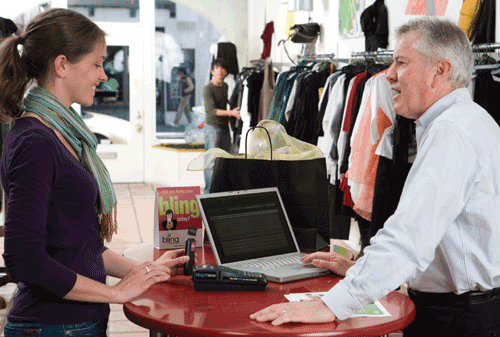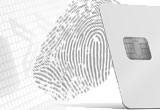Colorado town leading the way with contactless payments, rewards
01 March, 2010
category: Contactless, Financial, Library, NFC
By Ed McKinley, Contributing Editor, AVISIAN Publications
 Los Angeles dazzles, New York overwhelms and Chicago gets the job done on broad shoulders. But don’t look to America’s urban behemoths for the latest in payments technology. Tiny La Junta, Colo.–until now known mainly for melons, corn and cattle–is becoming one of the nation’s first hotbeds of open-loop, community-oriented, rewards-based wireless debit payments.
Los Angeles dazzles, New York overwhelms and Chicago gets the job done on broad shoulders. But don’t look to America’s urban behemoths for the latest in payments technology. Tiny La Junta, Colo.–until now known mainly for melons, corn and cattle–is becoming one of the nation’s first hotbeds of open-loop, community-oriented, rewards-based wireless debit payments.
Some 500 customers of The State Bank of La Junta automatically debit their checking accounts when they tap their cell phones on dedicated readers at more than 50 participating businesses in and around La Junta. Their town, a county seat of 8,000 residents far from the ski slopes and in the middle of relatively flat southeastern Colorado, could become a model for the nation, observers say.
A contactless chip in a Bling Nation sticker attached to their cell phones exchanges radio signals with the reader to pay for anything from a steak at Boss Hogg’s Saloon, a trim at the I Need Fabulous salon or a fill-up at any of the area’s five Tank N Tummy C-Stores.
Bling Nation authenticates the transactions over cell phone networks, eliminating steps that accompany more usual debit card purchases. No major card brands get involved in the authentication, so more money stays in the pockets of La Junta shoppers and merchants instead of electronically flying off into the coffers of Visa USA in San Francisco or MasterCard Worldwide in Purchase, N.Y.
But don’t get the idea the State Bank’s Redi-Pay Bling is just another pilot. The bank, merchants and townspeople are committed to the convenience, consumer rewards, low merchant fees, tight security and community spirit of wireless debit payments, says Brad Rose, a State Bank of La Junta vice president and IT security officer. The bank’s rivals are getting ready to offer the tags, too, Rose says, helping to make La Junta ground zero for the spread of wireless debit payments.
The birth of Bling in LaJunta
State Bank heard about Bling Tags in December 2008 from Rose’s brother, who was operating a micropayments company for digital media. That prompted discussions with Wenceslao Casares, a founder, director and co-CEO of Palo Alto, Calif.-based Bling Nation. State Bank began the Bling Tag project in earnest in February 2009 and began offering the tags to the public three months later, Rose says.
Casares explains that State Bank became the first paying customer for Bling Nation, which began pitching the system to bankers in 2007. Before the bank signed on, the vendor had tested the scheme in Palo Alto with Facebook employees serving as customers and several local restaurants accepting the tags.
E-mail alerts and anti-fraud procedures built into the Bling Nation system captured Rose’s imagination. “When I heard about the security features on the Bling tag, I just fell in love with the product,” Rose says. Any time a transaction breaches security parameters set by the bank, the system rings the account holder’s cell phone. When that call comes, the user enters a PIN number to complete the purchase. If the correct PIN isn’t entered, the transaction is not allowed.
Triggers include exceeding a set dollar amount in a single transaction, which State Bank established at $1,000; making more than a specified number of purchases in a defined time period; making total purchases of more than a set amount during a designated period; and making the 20th purchase at a single business, says Rose. Fewer than 5% of transactions require customers to enter their PINs, says Casares. In the first 25 days of November 2009, for example, State Bank’s 500 Bling Nation accounts set off triggers just 32 times, Rose says.
Convincing those 500 customers, nearly half of the bank’s 1,100 checking account holders, to attach the self-adhesive, postage-stamp-sized Bling Tags to their phones represented a victory for the bank, Rose says. To start that effort he himself photographed and narrated a video of a trip to the town’s Fox Theater to show how the tags worked. The theater shows the video before feature films, and it’s available for viewing on the bank Web site.
Postcards and statement stuffers meant to explain the tags failed to make much of an impression with account holders, according to Rose. From what he could determine, recipients simply glanced at the printed materials and tossed them into the trash or the recycling bin.
However, word-of-mouth brought success. First, State Bank executives briefed the tellers on the tags. Then, the tellers urged merchants to encourage shoppers to convert to the tags. Soon the bank began reaching its goals, he notes. “We went from 50 to 500 consumers very quickly,” he says.
Generous rewards drive usage
To help motivate townspeople, the bank and participating merchants are cooperating to underwrite rewards points valued at 3% of the purchases made with the tags. So a carpenter who buys a $100 miter saw at Ranchers Supply Co. earns enough points that he can then walk into the Barista coffee shop and buy a latte for points alone.
Merchants can add to the 3% rewards built into the system and they might do well to consider that option because the current system is proving too generous to last indefinitely, Rose says. For every $50 spent with a tag at one local bar, for example, the customer receives a $5 discount on the next visit. “More and more merchants are looking at rewards on top of the 3%,” he notes.
Bling Nation helps consumers keep track of the of the points flowing in and out by sending an electronic receipt to their cell phones for every transaction, Rose says. The receipts come as SMS text messages that note the number of points accumulated, where the points were obtained and the cash balance available in the checking account, he says.
Consumers also notice the quickness of the Bling Nation transactions, says Rose. Visa and MasterCard purchases can take 20 to 30 seconds when they require signatures, he claims, adding that the Bling procedure does not even require a paper receipt because it includes the electronic record on the shopper’s cell phone.
The look of the tags can heighten their popularity, too, and the State Bank tags come in “several flavors,” says Rose. Customers can state their politics by choosing a tag configured as a peace sign, demonstrate their loyalty to the local community by carrying one that says “Shop La Junta,” or promote the bank by using one with the financial institution’s mascot, a caricature of a railroader named “Redi,” that bears the slogan, “Redi to Make a Difference.”
State Bank still hopes to win over another couple of hundred tag converts at the main bank in La Junta and its branch about 15 miles away in Rocky Ford. The bank intends to extend the project this year to its other branch in the town of Falcon. The bank has determined the tags do not bring in new accounts, however, and thus decided to drop its claim to geographic exclusivity for the payment system.
One competing bank plans to introduce the tags in the first quarter and another is in talks with Bling Nation and intends to enter the field when the technology matures, Rose says. “There has been somewhat of a halo effect,” observes Casares. Merchants and then bankers have started to notice in towns near La Junta, and Rose has introduced it to bankers who have approached him, he says.
Merchant fees and terminal deployment
Before consumers can use the tags frequently enough to make them worthwhile, however, the State Bank had to achieve critical mass among local merchants willing to accept the payments. The bank began with a test at the Copper Kitchen and Wallace Oil Co. Both businesses were included in discussions with Bling Nation and quickly embraced the system, Rose says, noting that, “merchants don’t have anything to lose by going on it.”
In fact, merchants pay lower fees to Bling Nation than to the major card brands. At the 2% to 3% rate that Visa and MasterCard typically charge merchants, the merchant’s fee would come to $2 to $3 on a $100 transaction. The same transaction costs shopkeepers $1.33 with Bling Nation, Rose says. For a $1,000 purchase, the major card brands might assess a fee of $20 to $30, while Bling would charge the same $1.33, he continues. Bling Nation fees typically amount to 15 cents on purchases of $5 to $25, 30 cents on those of $25 to $75, 50 cents on purchases of more than $75 and a top rate of $1.33, Rose says.
Bling Nation fees vary for different types of merchants but all fall within four tiers, Casares says. A written explanation of the pricing system requires just half a page and is much simpler than the Visa and MasterCard pricing schedules, he says. Bling Nation often posts payments to merchants’ accounts on the day of the transaction, according to Rose.
The Bling process requires its own terminals, which Bling Nation provides to merchants free of charge, says Casares. The only wiring the terminals, or “Blingers,” need is a power cord to an electrical outlet. Batteries keep the terminals working during power outages and also empower the wait staff at La Junta restaurants, such as the Gold Panner Café and Thyme Square, to take payments tableside, says Rose.
The tags may serve as a predecessor to phones with built-in near field communication capabilities that perform a host of functions, says Casares. “It may just happen sooner than people expect with some open architecture phone just throwing a contactless chip in there and letting developers do whatever they want with it,” he adds.
This year, however, Bling Nation is limiting its growth by adding just one bank a month to its network despite increasing interest, Casares says. By starting small, the company can choose only banks that will benefit greatly from the tags, he says. Moreover, slow growth will give Bling Nation time to learn the intricacies of differing financial institutions, divergent local cultures in small towns and big cities, and changes in seasonality and geography that can affect marketing.
Through it all, State Bank has led the way, Casares says. “We have calls from banks on both coasts now, but it’s because they called this community bank in La Junta first,” he says. Bling Nation foresees a growth path with increasingly larger banks in ever-larger cities. In Colorado, for example, the company could work its way up to Denver by signing up more banks, merchants and consumers ever closer to the region’s big city. The growth would continue until, “you have a blanket of merchants around the Denver area that makes it compelling for a large bank to launch there,” he says.



